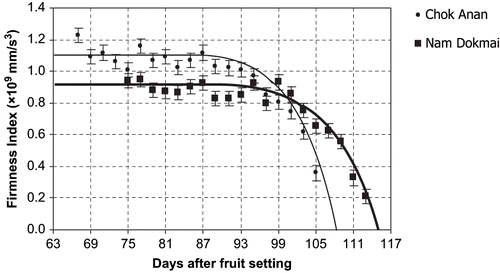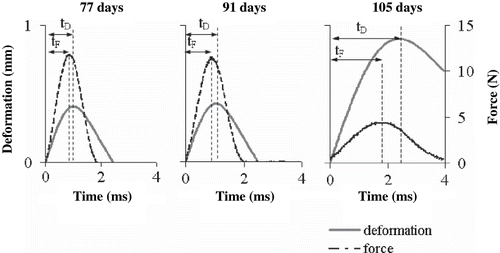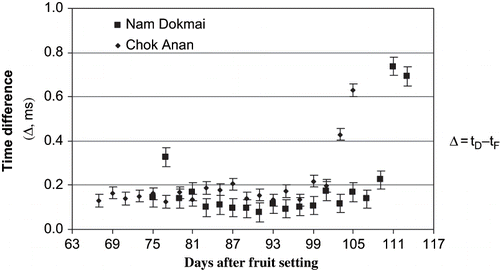Abstract
The purpose of this research was to determine the firmness of mango fruit at different stages of maturity. Immature, mature, and over mature fruit from two Thai mango cultivars (Nam Dokmai and Chok Anan) were subjected to two firmness measuring techniques: a slow compression technique using the Universal Testing Machine and a high-speed impact sensing technique using the low-mass impact tester. The firmness of a mango as determined by the compression test was expressed by the slope of the force-deformation graph, while firmness values derived from the impact test were defined by the ratio between maximum acceleration and the corresponding time (the firmness index). A very good correlation between the two indicators was obtained. Each firmness indicator of the two cultivars remained relatively unchanged from the immature through to the fully mature stage, although firmness rapidly decreased as the fruit ripened. The Chok Anan cultivar was firmer than the Nam Dokmai type throughout the development period. The impact method was able to determine mango firmness rapidly, accurately, and non-destructively.
Keywords:
INTRODUCTION
Firmness relates to the maturity of many agricultural products and is one of the measures of the quality of fruit and vegetables. Fruit firmness, in general, decreases as fruits become more mature and decreases rapidly as they ripen. Overripe or injured fruit is relatively soft.[Citation1] Firmness testing of the Thai table mango was carried out with the mango of Nam Dokmai cultivar the maturity of which ranged from 96 to 111 days after fruit set. By means of the penetrometer tests performed with an 11-mm tip the mango firmness was found to value from 54.8 to 42.8 N.[Citation2] Reyes et al.[Citation3] categorized “Solo” papaya into 5 stages of ripeness including mature green (dark green over entire surface) to three quarter ripe (three fourths yellow). Firmness of the papaya, measured by a 7.5-mm diameter spherical tip plunger mounted to a constant velocity texture analyzer, ranged from 129 to 16.5 N relating to the ripeness stages. Delwiche et al.[Citation4] separated firmness of “Bartlett” pears into two levels: below 44 N and above 70 N for the removal of the soft and the hard out of the mixture of the hard, firm and soft fruits. Destructive penetrometer techniques have been the favored methods of determining the firmness of this fruit.[Citation2,Citation4,Citation5,Citation6,Citation7]
Firmness tests for apple, kiwi fruit, and pear have taken several forms. Firmness has been ascertained from the peak force at a predetermined deformation, and also from the slope of the force-deformation curve at low compression force.[Citation7,Citation8,Citation9] Researchers have found that the impact of a fruit on a rigid surface can be closely modeled by the impact of an elastic sphere and that the firmness of a fruit has a direct effect on the impact force response.[Citation4,Citation10,Citation11] Nahir et al.[Citation12] reports that when tomatoes are dropped from a 70-mm height onto a rigid surface, the impact force response highly correlates with fruit weight and fruit firmness. They subsequently developed an experimental tomato grading machine which, by measuring and analyzing the impact force response of the fruit, could separate tomatoes on the basis of weight and color. Delwiche et al.[Citation5] also analyzed impact forces of peaches striking a rigid surface and found that certain impact force characteristics were highly correlated with the fruit's elastic modulus and penetrometer measurements of flesh firmness.
In addition, Delwiche[Citation5] simulated impact contact force model characterizing peak force of the hard, firm and soft fruit. He found that the peak force decreased and the contact time increased as a fruit's maturity increased. Accordingly, he proposed the impact force characteristics F/t2 (where F and t are the peak impact force and the time required to reach peak force, respectively) as a predictor of firmness. A single lane firmness sorting system was developed which used the index F/t2 to sort peaches and pears into hard, firm, and soft categories.[Citation6] Other methods of establishing fruit firmness using techniques of dropping the fruit on a sensor were developed by Younce and Davis[Citation13] and McGlone and Schaare.[Citation14] However, a problem inherent to this technique is that the impact force is also a function of the mass and radius of curvature of the fruit. Therefore, a large variation in these two parameters will affect the accuracy of firmness measurement.
A different approach is to impact the fruit with a small spherical impactor of known mass and radius of curvature and measure the acceleration of the impactor. The advantage of this method is that the impact-force response is independent of the fruit mass and is less sensitive to the variation of the radius of curvature of the fruit. This technique was first described by Chen et al.[Citation15] and was tested by several researchers investigating fruit firmness.[Citation16,Citation17,Citation18] Ruiz-Altisent et al.[Citation19] developed a system that used the impact parameters to classify apples, pears, and avocados into different firmness groups. Results of the study by Chen et al.[Citation20] indicated that using a low-mass impactor can result in the following desirable features: i) the measured acceleration signal increases; ii) both the magnitude of the calculated firmness index and the rate of change of firmness index with respect to fruit firmness increase; iii) the error due to movement of the fruit during the impact is minimized; iv) fruit damage caused by the impact is minimized; and v) high speed sensing is applicable. Based on these findings, a low-mass high-speed impact sensor was designed and tested on kiwi fruit and peaches with good results.[Citation8]
Determining the maturity and harvesting time of mango from specific gravity has also been investigated by researchers.[Citation2,Citation21] However, in practice, specific gravity is rarely applied to sorting in the modern packing line, although it can serve as an alternative monitoring indicator. Mango is one of the most economically important fruits in Thailand and is popular locally and abroad. However, nondestructive techniques for determining the firmness of Thai mangoes are currently not available. The development of knowledge about the firmness properties of mangoes and firmness measuring techniques would aid considerably in the future development of machines for high-speed sorting of mangoes for export. Therefore, the purpose of this research is to investigate the firmness properties of Thai mangoes and to evaluate and compare two different firmness measuring techniques.
MATERIALS AND METHODS
Two cultivars of Thai mango (Mangifera indica L. – cv. “Nam Dokmai”) and (Mangifera indica L.– cv. “Chok Anan”) were used in this study. Sample preparation began with coding mango bunches in the orchard at the commencement of fruit set. Twenty intact samples of Nam Dokmai mango were picked for experiment at the 75-day mark (Nam Dokmai reaches full maturity in 99 days after fruit set). Each fruit was selected for uniform size and then permanently coded, weighed by an OHAUS GT4100 electronic balance, and sized by a vernier caliper. Specific gravity measurement of the sample was then performed by means of the water displacement method described in Mohsenin.[Citation22] Following this process, the sample was surface dried by cloth, left in the testing room for one hour and then taken to the low-mass impact tester (similar to Chen et al.[Citation8]).
The impact tester consists of a free-falling impacting rod. This comprises a sectional cylindrical steel rod with a 6-mm diameter spherical tip weighing 12 g. Attached to the rod as one of its sections is a small high frequency accelerometer (BBN Model 501, miniature), with a sensitivity of 1 mV/ms−2 and a peak operating acceleration of 2050 m/s2. An electromagnet mounted on a vertical post releases the impacting rod at a specified height. As the impacting rod comes into contact with the sample, the signal from the accelerometer is fed to an Intel 8085A microprocessor-based data sampling and storage tool.
The fruit was placed under the impactor with one of its cheeks facing up so that its center was aligned to the center of the impactor. The opposite cheek was attached to a fixed base with modeling clay. The drop height (the distance from the impactor to the fruit surface) was consistently set at 2 cm. The selection of this drop height was based on a study by Chen et al.,[Citation20] which reported that a 2-cm drop height did not cause any bruising in Bartlett pears. After impact, acceleration of the impactor (a) and impact time (t) were measured, recorded, and analyzed. Given that the mass of the impactor (m), the drop height, and impact acceleration were all known, force (F) and deformation (D) during the impact could be calculated as follows:
The opposite cheek of the impacted mango was subjected to the compression test using the universal testing machine (Instron 5569). The machine was equipped with the same impactor head as that used in the previously described experimental process. Compression load was applied at a loading rate of 25 mm/min[Citation23] until the sample was ruptured. Force deformation response data were transferred from the Instron system to a computer for further analysis. The same procedure was repeated for the other nineteen mangoes (20 replications/experiment were performed).
The same experiment was repeated every two days. Therefore, a total of 20 experiments occurred over 40 days, which accommodates the most important fruit development period from the immature to over-mature stage. Experiments involving Nam Dokmai fruit started on the 75th day after fruit set (Nam Dokmai reaches full maturity in 99 days), and on the 67th day for Chok Anan, which reaches full maturity 91 days after fruit set.
RESULTS AND DISCUSSION
Impact Measurement
shows the relationship between the average firmness of Nam Dokmai and Chok Anan mangoes as expressed by the firmness index (A/t: A = peak impact acceleration (mm/s2); t = time at A (s)). Maturity is determined by the number of days after fruit setting. Data distribution was well fitted by the Weibull model (“Curve Expert Program”, a public domain software), giving the equation A/t = 0.89 − 48.9 e−1.6E8X −3.7 (R2 = 0.98) for Nam Dokmai and A/t = 1.09 − 245.62 e−5.7E5X −2.5 (R2 = 0.97) for Chok Anan (where X represents days after fruit setting). This means the firmness of the two cultivars remain relatively constant throughout the maturation period until they became fully mature. A/t started to drop at X = 99 for Nam Dokmai and at X = 91 for Chok Anan. After full maturity the firmness index of both fruit dropped rapidly (0.051 E-9 mm/s3 per day for Nam Dokmai and 0.048 E-9 mm/s3 per day for Chok Anan) until the fruit became very soft. The firmness distribution curve of Chok Anan looks similar to that of Nam Dokmai except that Chok Anan reaches full maturity earlier and the firmness drops at a slightly slower rate than Nam Dokmai does after full maturity. Chonhenchob and Singh[Citation24] applied the low-mass impact set-up (similar to Chen et al. (1996c)) to study the bruise susceptibility of Nam Dokmai mango and found that firmness index values of the immature mango are not significantly different to those of mature fruits. They suggested resistance to bruising in mature mangoes would be similar to that displayed by immature mangoes. The results presented in show some agreement with the conclusions arrived at by Chonhenchob and Singh.[Citation24]
Compression Test
The force F was fairly proportional to deformation D for both cultivars in the period leading up to the rupturing of the fruit by the pressure tip. Following this event, the slope of the F-D graph was estimated at a loading below the yield point (50% of rupture force). The average value of the slope of 20 fruit was represented by a point and plotted against the number of days after fruit setting. The plots of compressive firmness, determined by the slope of the force-deformation curve and with respect to the number of days after fruit setting, are shown in . The two graphs look very similar to those of A/t obtained with the impact technique and are also well fitted by the Weibull model. The fitted Weibull equation for compression firmness of Nam Dokmai is
Figure 2 Relationship between average slope of the force-deformation curve under slow compression and the maturity time of Nam Dokmai and Chok Anan mangoes. Each point represents an average of 20 fruits.
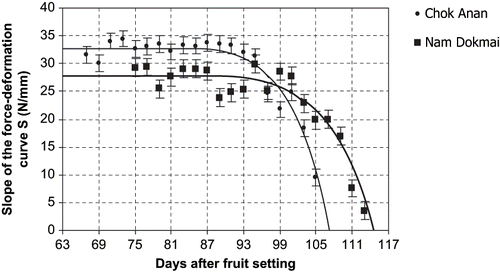
and for Chok Anan:
The sensation obtained by manual touching indicates that mangoes of both cultivars are about as firm at the mature stage as at the immature stage. This also agrees with the information in , which suggests that the ratio of force change to deformation change is about constant during the immature-mature stage. Again after full maturity, mango firmness dropped quickly to the soft stage at rates of about 1.804 N/mm per day (Nam Dokmai) and 1.730 N/mm per day (Chok Anan). Details of A/t and compression slopes are given in . The influence of cultivar on the relationship between impact firmness and slow compression firmness (expressed by the A/t divided by S) was analyzed as a result of two observations: (a) the behavior of the force-deformation slope resembles that of the firmness index for both cultivars in that they manifested as a straight line in the immature to mature stage and convex in the mature to over mature stage; and (b) the dropping rate of the compression slope graphs and firmness indexes for the cultivars only showed small differences. Cultivar did not affect the ratio of A/t to S at the significance level of 5%.
Table 1 Mean and standard derivation of firmness properties of selected mangoes
graphs the relationship between the A/t and S of a mango. Good linear correlation was found (A/t = (0.0295S + 0.0865)109 @ R2 = 0.94). From this, the force-deformation firmness indicator of a mango can be estimated sufficiently precisely by the nondestructive impact firmness index. The low-mass impact technique is more suitable for high-speed sensing and, therefore, can potentially be used in a high-speed online sensing system for the firmness sorting of mangoes.
Figure 3 Linear relationship between impact firmness index A/t and slow compression slope S of a mango.
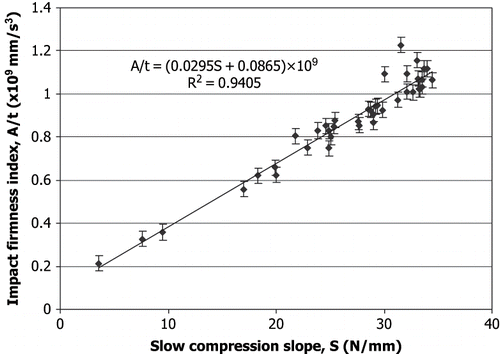
shows the distribution of force with respect to time during impact at different stages of maturity. As the fruit matures, peak impact force decreases while t increases. This corresponds with the findings of Delwiche[Citation5] and Lichtensteiger et al.[Citation11] Mango is firm at full maturity but becomes less firm when getting over mature and is soft at ripening. It was observed that, due to viscoelastic effects (stress and strain that are dependent on time), the impact force peaks before the deformation reaches its peak. shows that the difference between the time at peak force (tF) and the time at peak deformation (tD) remains small when the fruit is immature (77 days) and fully mature (91 days after fruit set). During this period the time difference Δ (Δ = tD – tF) is less than 0.2 ms (). As the fruit ripens, Δ increases to above 0.6 ms. This indicates that mangoes are quite elastic until they reach full maturity and become more viscoelastic as they ripen.
Specific Gravity Measurement
shows the distribution of specific gravity (SG) of Nam Dokmai mango with respect to fruit age covering the immature, mature and over mature periods. Based on linear regression, specific gravity of Nam Dokmai linearly increases with the number of days after fruit setting, resulting in the equation of SG = 0.873 + 1.56E-3X (R2 = 0.895). Specific gravity statistics are detailed in . Specific gravity at full maturity (X = 99) is 1.027, which is close to the observations of Kasantikul et al.[Citation2] (specific gravity at full maturity = 1.03). Poor linear correlation was found with Chok Anan mangoes (R2 = 0.32).
Figure 7 Specific gravity of Nam Dokmai mango with respect to days after fruit setting. Each point represents 20 fruits.
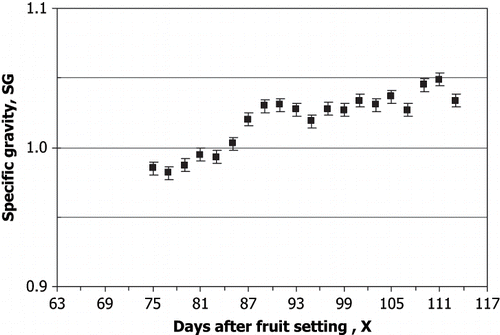
Table 2 Mean and standard deviation of specific gravity of Nam Dokmai
CONCLUSION
Thai mangoes of two cultivars, “Nam Dokmai” and “Chok Anan”, demonstrated similar firmness properties according to the firmness index and force-deformation slope. For a particular cultivar, both firmness indicators illustrated similar distribution graphs of the firmness indicators with respect to maturity and were well modeled by the Weibull equation. Very good correlation between both indicators was obtained for a mango without the influence of cultivar. Typically, in the case of both cultivars, firmness is quite constant from immaturity until full maturity, but drops rapidly as the fruit ripens. Chok Anan is firmer than Nam Dokmai in both types of measurements (19.5% in the compression test and 16.0% in the low mass impact test). Our findings indicated that the impact and compression techniques may not be suitable for differentiating immature from mature mangoes. On the other hand, both techniques are suitable for determining the level of ripeness after the fruit reaches the full maturity stage. The impact technique has the advantage of being easily adaptable to high-speed online sorting.
ACKNOWLEDGMENTS
The authors gratefully acknowledge the Postgraduate Education and Research Development Project in Postharvest Technology, Chiang Mai University, Thailand, for financial support. Deep appreciation is given to Prof. P. Chen, Professor Emeritus of Department of Biological and Agricultural Engineering, University of California, Davis, USA for his valuable guidance.
Notes
1. Chen, P. In Quality Evaluation Technology for Agricultural Products, Proceedings of the International Conference on Agricultural Machinery Engineering, Seoul, Korea, November 12–15, 1996.
8. Chen, P.; Tjan, Y.; Ruiz-Altisent, M. In A Low-Mass Impact Sensor for High-Speed Firmness Sensing of Fruit, Proceedings of the International Conference on Agricultural Engineering AgEng. 96, Paper no. 96F-003, Madrid, Spain, September 23–26, 1996.
14. McGlone, V.A.; Schaare, P.N. In The Soft Sort Fruit Firmness Grader, Abstract Book of PH'96 International Postharvest Science Conference, Taupo, New Zealand, August 4–9, 1996.
16. Jaren, C.; Ruiz-Altisent, M.; Perez de Rueda, R. In Sensing Physical Stage of Fruits by Their Response to Non-Destructive Impacts, Proceedings of AGENG 92, Paper no. 9211-113, 1992.
17. Correa, P.; Ruiz-Altisent, M.; dela Plaza, J.L. In Physical Parameters in Relation to Physiological Changes of Avocado during Ripening (20°C) and Cold Storage (6°C) in different conditions, Proceedings of AGENG 92, Paper No. 9211-16, 1992.
19. Ruiz-Altisent, M.; Jaren, C.; Correa, P. In Fruit Quality Sensing: Post-harvest Ripeness, Proceedings of the 4thInternational Symposium on Fruit, Nut, and Vegetable Production Engineering, Paper No. 935-25; Valencia-Zaragoza, Spain, March 22–26, 1993.
22. Mohsenin, N.N. Physical Properties of Plant and Animal Materials; Gordon and Breach Publishers: Thailand, 1996; 891 p.
REFERENCES
- 1. Chen, P. In Quality Evaluation Technology for Agricultural Products, Proceedings of the International Conference on Agricultural Machinery Engineering, Seoul, Korea, November 12–15, 1996.
- Kasantikul , D. , Ketsa , S. and Kosiyachinda , S. 1984 . Harvesting Indices of Mango cv Nam Dokmai . Kasetsart University Journal (Natural Science) , 18 : 55 – 60 . (in Thai).
- Reyes , M.U. , Paull , R.E. , Williamson , M.R. and Gautz , L.D. 1996 . Ripeness Determination of ‘Solo’ Papaya (Carica Papaya L.) by Impact Force . Applied Engineering in Agriculture , 12 ( 6 ) : 703 – 708 .
- Delwiche , M.J. , Arevalo , H. and Mehlschau , J.J. 1996 . Second Generation Impact Force Response Fruit Firmness Sorter . Transactions of the ASAE , 39 ( 3 ) : 1025 – 1033 .
- Delwiche , M.J. 1987 . Theory of Fruit Firmness Sorting by Impact Forces . Transactions of the ASAE , 30 ( 4 ) : 1160 – 1166 .
- Delwiche , M.J. , Tang , S. and Mehlschau , J.J. 1989 . An Impact Force Response Fruit Firmness Sorter . Transactions of the ASAE , 32 ( 1 ) : 321 – 326 .
- Abbott , J.A. and Liljedahl , L.A. 1994 . Relationship of Sonic Resonant Frequency to Compression Tests and Magness-Taylor Firmness of Apples during Refrigerated Storage . Transactions of the ASAE , 37 ( 4 ) : 1211 – 1215 .
- 8. Chen, P.; Tjan, Y.; Ruiz-Altisent, M. In A Low-Mass Impact Sensor for High-Speed Firmness Sensing of Fruit, Proceedings of the International Conference on Agricultural Engineering AgEng. 96, Paper no. 96F-003, Madrid, Spain, September 23–26, 1996.
- Grotte , M. , Duprat , F. , Pietri , E. and Loonis , D. 2002 . Young's Modulus, Poisson's Ratio, and Lame's Coefficients of Golden Delicious apple . International Journal of Food Properties , 5 ( 2 ) : 333 – 349 .
- Delwiche , M.J. , McDonald , T. and Bowers , S.V. 1987 . Determination of Peach Firmness by Analysis of Impact Forces . Transactions of the ASAE , 30 ( 1 ) : 249 – 254 .
- Lichtensteiger , M.J. , Holmes , R.G. , Hamdy , M.Y. and Blaisdell , J.L. 1988 . Impact Parameters of Spherical Viscoelastic Objects and Tomatoes . Transactions of the ASAE , 31 ( 2 ) : 595 – 602 .
- Nahir , D. , Schmilovitch , A. and Ronen , B. 1986 . Tomato Grading by Impact Force Response, ASAE Paper No. 86–3028; American Society of Agricultural Engineers . St. Joseph, Michigan ,
- Younce , F.L. and Davis , D.C. 1995 . A Dynamic Sensor for Cherry Firmness . Transactions of the ASAE , 38 ( 5 ) : 1467 – 1476 .
- 14. McGlone, V.A.; Schaare, P.N. In The Soft Sort Fruit Firmness Grader, Abstract Book of PH'96 International Postharvest Science Conference, Taupo, New Zealand, August 4–9, 1996.
- Chen , P. , Tang , S. and Chen , S. 1985 . Instrument for Testing the Response of Fruits to Impact, ASAE Paper no. 85–3537; American Society of Agricultural Engineers . St Joseph, Michigan ,
- 16. Jaren, C.; Ruiz-Altisent, M.; Perez de Rueda, R. In Sensing Physical Stage of Fruits by Their Response to Non-Destructive Impacts, Proceedings of AGENG 92, Paper no. 9211-113, 1992.
- 17. Correa, P.; Ruiz-Altisent, M.; dela Plaza, J.L. In Physical Parameters in Relation to Physiological Changes of Avocado during Ripening (20°C) and Cold Storage (6°C) in different conditions, Proceedings of AGENG 92, Paper No. 9211-16, 1992.
- Wang , J. and Teng , B. 2006 . Firmness Evaluation by Drop Impact Characteristics for Peach . International Journal of Food Properties , 9 ( 3 ) : 439 – 451 .
- 19. Ruiz-Altisent, M.; Jaren, C.; Correa, P. In Fruit Quality Sensing: Post-harvest Ripeness, Proceedings of the 4thInternational Symposium on Fruit, Nut, and Vegetable Production Engineering, Paper No. 935-25; Valencia-Zaragoza, Spain, March 22–26, 1993.
- Chen , P. , Ruiz-Altisent , M. and Barreiro , P. 1996 . Effects of Impacting Mass on Firmness Sensing of Fruits . Transactions of the ASAE , 39 ( 3 ) : 1019 – 1023 .
- Narayana , C.K. , Pal , R.K. and Roy , S.K. 1999 . Specific Gravity and Its Influence on Maturity of Mango cv. Baneshan . Jour. Appl. Hort. , 1 ( 1 ) : 41 – 43 .
- 22. Mohsenin, N.N. Physical Properties of Plant and Animal Materials; Gordon and Breach Publishers: Thailand, 1996; 891 p.
- ASAE Standard . 1998 . “ Compression Test of Food Materials of Convex Shape, ASAE S 368, 3 MAR 95 ” . In American Society of Agricultural Engineers , Michigan : St. Joseph .
- Chonhenchob , V. and Singh , S.P. 2003 . A Comparison of Corrugated Boxes and Reusable Plastic Containers for Mango Distribution . Packag. Technol. Sci. , 16 : 231 – 237 .
